Q&A with 2021 SCEC Annual Meeting Presenters
The 2021 SCEC Annual Meeting (held online) was a phenomenal success with more than 800 registrants from 229 organizations worldwide! This included 216 first-time attendees, and 169 who have attended 10 or more Annual Meetings. Nearly half of the registrants were early-career researchers, several whom were featured as speakers during plenary sessions. Many attendees were also co-authors of the 267 posters presented.
Abstracts for plenary talks and posters remain available for online viewing; many have recorded presentations and/or lightning talks that can still be viewed (depending on viewing permissions established by the authors).
To provide additional background about several plenary session researchers and their presentations, we sent a few simple questions to several presenters. Their responses and links to their presentations are below.
|
|
|
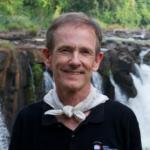 |
My Sojourn into and through Paleoseismology (Distinguished Speaker Presentation) Kerry Sieh, Earth Observatory of Singapore, Nanyang Technological University (Emeritus Director) |
| What motivated you to study earthquakes?
Late in my undergrad years at UCR, I was inspired by the first Moon landings to study moon rocks. But so many of my Christian friends were going off to be missionaries or to Bible school, that I felt guilty doing something so esoteric. Sitting in on a talk at the GSA Cordilleran Section meeting at UCR in 1971 inspired me to try something that might be more “useful,” using geology to figure out the timing between large earthquakes. That led to a few of us getting an undergrad grant from NSF to carry out a proposal for such work on the San Jacinto fault. That didn’t work out so well, but after I started grad school, my thesis advisor gave me, as he later said, “just enough rope to hang yourself.” That is, a few hundred dollars to start measuring small offsets along the San Andreas fault. But without the NEHRP program, which had just been started in the mid-1970s, I never would have had the support to do what became known as paleoseismology. How has participation in SCEC contributed to your career? Being on the Board of Directors was the first time I’d ever been asked to lead in planning a scientific effort. That experience was good preparation for a few years later conceiving of and writing the proposal for the Earth Observatory of Singapore and Asian School of the Environment there. |
|
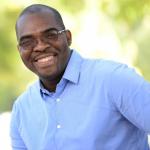 |
Investigating the Influence of Topography on Rupture Propagation along Fault Stepovers
Roby Douilly, University of California, Riverside (Assistant Professor) |
| What motivated you to study earthquakes?
Earthquake seismology wasn’t always a passion of mine. I was born and raised in Haiti and did my undergraduate studies in Civil Engineering at the Université d’Etat d’Haïti (State University of Haiti). At that time, I had had some geology classes, but didn’t know anything about seismology. A few months before I defended my thesis for my Bachelor of Science, the 2010 M7.0 earthquake happened. This event caused more than 200,000 deaths and left more than a million people homeless. After experiencing this devastating earthquake, I felt compelled to learn about earthquakes, and I was motivated to pursue a career in earthquake seismology. Luckily, I was offered an opportunity to do my graduate studies at Purdue University where I later obtained my masters and PhD in Geophysics. How has participation in SCEC contributed to your career? I still consider myself an early career scientist, and I only began to actively participate in SCEC when I started my postdoc in 2016. Therefore, this list will only get bigger as the years go by. A lot of the work that is currently being done in my research group at UCR started by gathering research ideas from interactions with my peers during SCEC events. For example, the study that I just presented during the 2021 SCEC Annual Meeting was in part constructed after following the work presented during the 2020 SCEC Cajon Pass virtual workshop. Also, participating in SCEC attracts more people to pay closer attention to my work (more visibility) and thus promotes more collaborations and opportunities such as serving on the SCEC Equity Diversity and Inclusion committee. What might a non-scientist need to know before viewing your presentation? Fault traces are regularly discontinuous, and based on past earthquakes, we know that major earthquakes often involve rupture across multiple fault segments. The separation between two consecutive segments (referred to as stepover width) can be small (~1km) or big (≥5km) and depending on that width, rupture could either stop or propagate through the discontinuity and thus influence the final earthquake size. While there are some rare cases where an earthquake rupture was able to propagate across a stepover width greater than 5 km, historical surface ruptures and earthquake simulations have suggested that large stepover widths (≥3—5km wide) are likely to stop a rupture. However, as we can observe in many places such as in Southern California, complex fault systems are often located in regions with high and asymmetric topography, and we haven’t examined in much detail the impact of topography on rupture behavior. Therefore, in this study, I wanted to investigate whether topography such as a high mountain range can affect rupture behavior on a nearby stepover fault system. The results suggest that topography seems to have a significant impact on rupture propagating across a stepover width of 3—5km. |
|
 |
Characteristics of earthquakes in damaged, heterogeneous, and temporally evolving fault zones
Yihe Huang, University of Michigan–Ann Arbor (Assistant Professor) |
| What motivated you to study earthquakes?
When I was an undergrad in civil engineering, I touched on some earthquake engineering research. I found topics on earthquakes more interesting than buildings. They made me wonder what kind of mechanical processes are involved in the generation of earthquakes. How has participation in SCEC contributed to your career? Participation in SCEC really helped shape my views on earthquake research and had a long-lasting impact on the research I've been working on. I started attending the SCEC annual meetings almost every year since I was a PhD student. I was always amazed by how much people could learn during the SCEC meeting. How might you describe the key results or implications of your Annual Meeting talk topic to a reporter? |
|
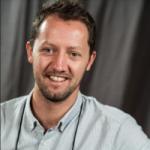 |
Characterizing the Deformation and Hazard of Fault Zones Using Geodetic Imaging Data
Chris Milliner, Caltech (Postdoctoral Scholar) |
| What motivated you to study earthquakes?
What drew me to earthquake science is that I found not only the phenomenon itself interesting, but really it is something that directly affects people. I felt motivated by the idea that as scientists if we can understand the underlying process we can better prepare and mitigate for its effects. The spark for me really happened while I was traveling through Sumatra and I saw first-hand the building collapse in the city of Padang during the 2009 Mw 7.6 earthquake. This really brought it home and I started to see this as something more than just scientific fascination. How has participation in SCEC contributed to your career? The SCEC annual meetings are such a highlight as it’s a smaller conference with an informal friendly setting. This allows you to relax, engage more easily and think creatively with others, without the rush and pressure of larger conferences. The other thing I find really unique about SCEC is the feeling of having a supportive and positive community that allows for a free discussion of a range of ideas and I think what helps make it such a creative space. I’m very privileged to feel this support and I am encouraged that the community is striving to make others feel just as welcomed and accepted. Having more diverse problem solvers from a range of backgrounds will help all of us generate more innovative solutions and I can only see SCEC getting stronger going forward. How might you describe the key results or implications of your Annual Meeting talk topic to a reporter? The Ridgecrest earthquake that we looked at was interesting for a number of reasons, particularly as it was the first major earthquake to have happened in California in the era of modern geodetic, seismologic and field instrumentation. So, I’m really excited about what has already come out and what we’ll continue to learn with these new methods. Our contribution focused on analysis of optical satellite imagery from the visible spectrum, as opposed to radar, where these data are starting to achieve such a fine spatial resolution that we can start to resolve how the material across the fault zone deforms and in turn understand what factors affect the surface rupture width. These observations are really critical for hazard estimates of fault displacement rupture at the surface as they constrain the probability estimates of displacement magnitude for a given location, which are used by engineers to set the building design criteria. These are typically used for instance, to understand how a road, bridge, gas pipeline, dam or nuclear facility should be designed if it crosses a fault or is located x distance from one? Refining these probability models and understanding what factors can explain and reduce their epistemic uncertainty is important as it will lead to estimates with higher confidence and better-informed building design. Here, our study showed that the rupture zone width is not constant along-strike but seems to be largely affected by the fault orientation relative to the loading stress direction which affects the type of strain response of the fault zone. Regions where the near-surface material experiences dilatation or extension, the fault zone is wider, while regions where the crust undergoes shear or differential motion, the fault zone is narrower. This is well understood in lab experiments as rocks are weaker in tension, and it was encouraging that this was well supported by our satellite observations at the rupture scale. We argued that these different strain responses of the fault-zone justify treating these extensional bends and shear segments differently in fault displacement hazard analysis by using different probability models. Of course, our study was from just one earthquake, and we are now looking to compile observations from a number of events to try and generalize this type of fault strain behavior. What I think is exciting now is collaborating with others in the SCEC community to use our satellite observations to help calibrate their numerical models that simulate the distributed fracturing process generated during dynamic rupture. These physics-based rupture simulations are the future for fault displacement hazard analysis which is a nascent field, likely to go in the direction and hopefully catch up with the more mature field of seismic shaking hazard analysis which is already starting to incorporate SCEC’s Cypershake. This collaborative community research effort I think will be the most effective means to better prepare for earthquakes and mitigate their effects, that will ultimately lead to better design of buildings to prevent collapse and more resilient cities that are still livable after a major earthquake. |
|
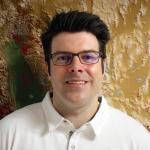 |
The SCEC community fault model: challenges, progress, and the future
Scott Marshall, Department of Geological and Environmental Sciences, Appalachian State University (Professor) |
| What motivated you to study earthquakes?
My Master’s research involved studying fracturing on Jupiter’s moon, Europa. I found this work fascinating, but for my PhD, I wanted to work on something closer to home with a more direct impact on society. I have always been fascinated by fracture mechanics and a graduate course in tectonics introduced me to satellite geodesy and the use of GPS for measuring tectonic plate motions. I found it amazing that it is possible to measure mm-scale motions of the surface of the Earth from space. I wanted to know more. I still want to know more! How has participation in SCEC contributed to your career? SCEC has been a critical and positive part of my career since starting my PhD. Not only was much of my PhD research SCEC-funded, being part of the SCEC community made me feel like my research was part of a larger effort - the goal of better understanding earthquakes in southern California and earthquake physics/geology in general. Since starting my own academic career, SCEC has been pivotal for me in maintaining relationships, making new collaborations, keeping up to date on the latest research, and just generally being part of a great community. Several of my research collaborations started with a casual conversation during lunch or dinner at a SCEC meeting. My home department does not have a graduate program, but being a part of SCEC has helped me to stay involved in the earthquake community and find ways that I can make meaningful contributions. I currently serve on the SCEC Science Planning Committee, am a co-leader of the Community Modeling group (CXM), and am a developer of the SCEC Community Fault Model. What might a non-scientist need to know before viewing your presentation? In the simplest sense, faults are a type of fracture (or crack). Think of any fracture you have seen in everyday life - for example, cracks in concrete or broken glass or ice. These cracks have a complex three-dimensional shape and often interact and intersect with each other. Geologic faults are similar in that they also have a complex three-dimensional geometry and often intersect, usually underground in the subsurface. Most of us have probably seen a map with fault lines (referred to as fault traces). These complex fault traces are just the very top of the fault surface. The complete fault is, in reality, a three-dimensional surface that extends miles underground. The sizes and shapes of faults partly control how often they can produce earthquakes and how large these earthquakes can be. So, it is critical to have a model, or representation, of what faults look like in three-dimensions. This is what the SCEC Community Fault Model provides – a three-dimensional model of what faults in southern California look like (geometrically speaking). A model like the Community Fault Model provides the starting geometry needed for many different types of critical earthquake studies including things like seismic hazard assessments, and numerous different types of computational models of faulting. Because SCEC provides the Community Fault Model to the community, researchers can spend their time working on improving their modeling methods instead of having to spend countless hours creating a starting model of the geometry of faults in southern California. My talk provides an overview of some of the challenges associated with producing the SCEC Community Fault Model, and how we have made progress to meet these challenges. |
|
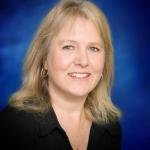 |
Pandemic lessons for earthquake resilience (Presentation available 10/19)
Lisa Grant Ludwig, Department of Population Health & Disease Prevention, UC Irvine (Professor and Chair) |
| What motivated you to study earthquakes?
My interest in earthquakes started around dawn on February 9, 1971 when the Sylmar / San Fernando earthquake jolted me out of bed and tossed my toys on the floor. Our house was not damaged, but our church collapsed into a heap of concrete rubble with shards of colorful glass. I was both terrified by the immense power of the earthquake and fascinated by the different impact on two places where I previously felt safe. I wanted to understand what causes earthquakes, how earthquakes affect people, and how we can protect ourselves. How has participation in SCEC contributed to your career? SCEC has been invaluable to my career. I was a PhD student at Caltech when SCEC started, way back in 1991. SCEC meetings, seminars and field trips provided opportunities to meet leading scientists in an informal, non-intimidating environment, with good food, good conversation and great science! At every stage of my career, SCEC provided unparalleled opportunities to connect with potential collaborators, mentors and students in meaningful ways. Collaboration and mentorship are essential for a sustainable career in science. Thank you, SCEC! How might you describe the key results or implications of your Annual Meeting talk topic to a reporter? There are several pandemic lessons for earthquake resilience. Human actions can mitigate or exacerbate the impact of infectious disease and earthquakes. People are both part of the problem and part of the solution. We need scientists to understand problems and develop solutions informed by data. Scientists must step out of our comfort zone and partner with others to develop effective policy solutions. Scientific leadership matters! View Presentation (available 10/19) |
|




